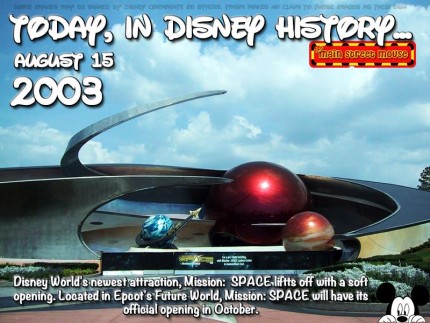Today In Disney History ~ August 15th
From Wiki:
Mission: Space (stylized as Mission: SPACE) is a centrifugal motion simulator thrill ride at Epcot in Walt Disney World. It simulates what an astronaut might experience aboard a spacecraft on a mission to Mars, from the higher g-force of liftoff to the speculative hypersleep.
The attraction opened to the public in a “soft opening” mode in June 2003, and celebrated its grand opening on October 9 with a ceremony attended by Disney CEO Michael Eisner, HP CEO Carly Fiorina and NASA Administrator Sean O’Keefe, as well as several NASA astronauts from its many phases of human space exploration (Mercury, Gemini, Apollo, the space shuttle program and two crew members aboard the International Space Station).
The attraction was built on the former site of Horizons, a dark ride that offered optimistic visions of what life might be like in the future. Horizons closed permanently in 1999 after a few years of sporadic operation; construction began on Mission: Space shortly thereafter. Industry estimates put the cost of developing the new attraction at US$100 million. The pavilion, like others at Epcot, features a VIP lounge for HP employees called The Red Planet Room.
Mission: Space is meant to simulate astronaut training for the first manned mission to Mars aboard the fictional X-2 Deep Space Shuttle in 2036, right after the seventy-fifth anniversary of Yuri Gagarin becoming the first human to enter space. (The year 2036 can be deduced from plaques in the attraction’s queue celebrating 75 years of human spaceflight, including two faux milestones in the future.) Riders are “trainees” at the fictional International Space Training Center (ISTC), where they are arranged into crews of four before watching an introductory video featuring actor Gary Sinise, who starred in the space dramas Apollo 13 and Mission to Mars.
Before boarding the simulators, each rider is assigned an on-board role (navigator, pilot, commander or engineer) and given two tasks to perform during the mission (pressing a specific button when prompted). For example, one of the commander’s buttons initiates the rocket’s first-stage separation, and the other activates manual flight control. The spacecraft’s on-board self-automated pilot will perform each task if the rider does not respond to his or her prompt from Mission Control or if there is no one to perform the task. Also featured are various labeled buttons and switches which the rider may play with but do nothing; they are only there to add to the realism aspect of the ride.
The mission includes liftoff from the ISTC, a slingshot around the moon for a gravity-assisted boost, a brief period of simulated hypersleep (to pass the lengthy time required to reach Mars) and a descent for landing on the Martian surface, where riders manually control the vehicle with a joystick. As a training exercise, the mission contains several unexpected situations that add to the drama.
The futuristic X-2 vehicle is a three-stage rocket which is said to use several technologies in development today, including aerospike engines, solid hydrogen fuel, an aerobrake and carbon nanotubes.
The attraction queue contains several items and commemorative plaques from past, present and fictional future space missions. Among the items on display are props from the 2000 film Mission to Mars, including the rotating “gravity wheel” from the predecessor X-1 spacecraft, a model of which hangs from the ceiling, and a replica of a NASA moon rover from the Apollo program.
Upon conclusion of the training exercise, guests are invited to participate in activities at the Advanced Training Lab, a post-show area containing a group game called Mission: Space Race in which players perform tasks as Mission Control technicians aiding two X-2 spacecraft racing to return to Earth; a space-themed play area for toddlers; a single-person, arcade-style game in which an astronaut explores Mars on foot; and a kiosk where brief video postcards can be created and sent via e-mail.
The attraction is a multiple-arm centrifuge that achieves the illusion of acceleration by spinning and tilting sealed capsules during the four-minute “mission.” Fans blow air gently at riders to help avoid motion sickness, and a magnified display in front of each rider simulates a window to space with high-resolution computer-generated imagery. Mission: Space comprises four separate centrifuges, each with 10 capsules holding four riders.
The attraction exposes riders to forces up to 2.5G, more than twice the force of gravity at the Earth’s surface (effectively multiplying a rider’s weight by 2.5). A few months after the ride’s opening, motion sickness bags were added within easy reach of riders.
TMSM Today in Graphic by Sherry Rinaldi DeHart
- Tinker Bell/Fairy Solar Garden Decorations, Set of Two! - March 14, 2025
- Mickey and Minnie Matching Bathroom Decor, Magical Makeover! - March 13, 2025
- Rachel Zegler Performs “Waiting on a Wish” in Spain - March 13, 2025
Our Official Travel Partner of The Main Street Mouse is MEI-Travel & Mouse Fan Travel

Mouse Fan Travel® an Authorized Disney Vacation Planner, has been planning and creating magical Disney vacations since 2005. Their mission is to provide premium service and expert advice to help you get the most for your vacation time and dollar. Their Disney Travel Agents operate with the highest degree of integrity and will handle your family vacation, reunion, honeymoon, corporate incentive trip or getaway, as if it were their own. They pride themselves on expertly representing and advocating for you – their client.
The next time you and your family are planning a Disney vacation, visit Mouse Fan Travel for your no obligation quote or to answer any Disney vacation questions you may have. Are you looking for a beach vacation, tour or cruise to destinations across the globe? Visit MEI-Travel for exceptional expertise with ZERO agency fees.







